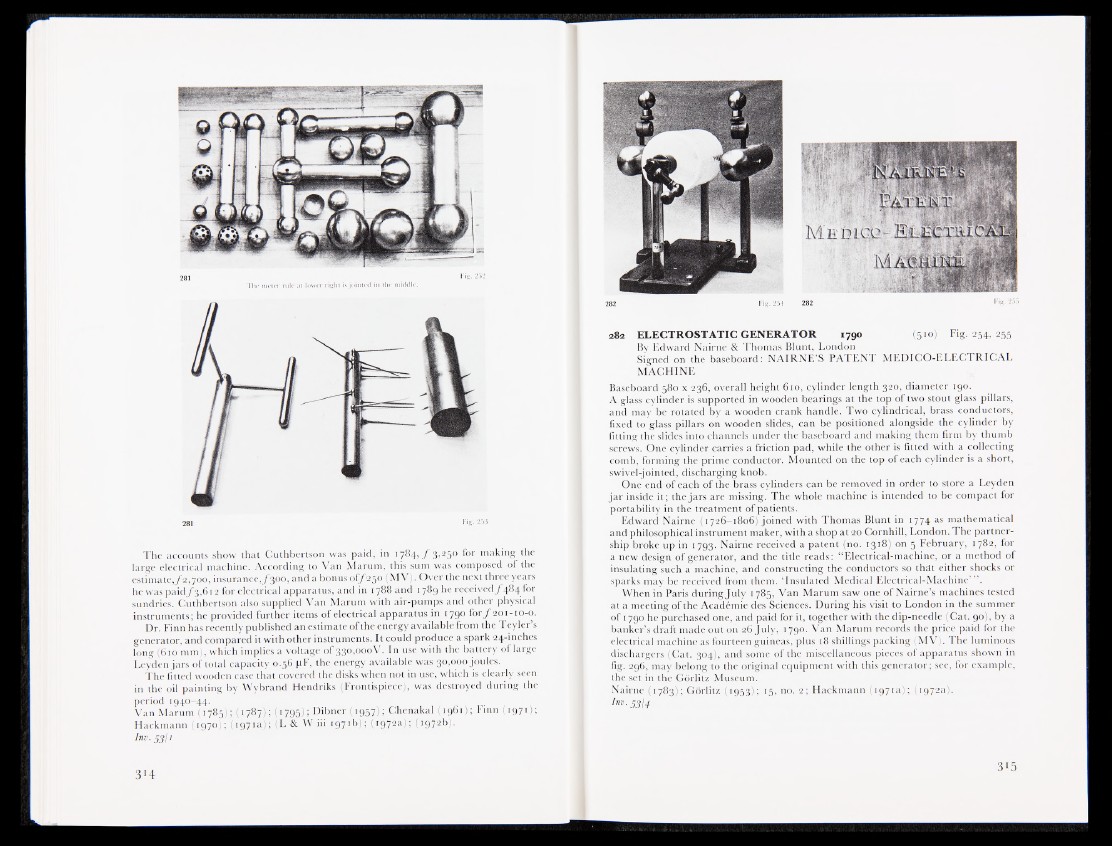
The accounts show that Cuthbertson was paid, in 1784, ƒ 3,250 for making the
large electrical machine. According to Van Marum, this sum was composed of the
estimate^2,700, insurance, f 300, and a bonus 0^250 (MV). Over the next three years
he waspaid/3,6i2 for electrical apparatus, and in 1788 and 1789 he received ƒ 484 for
sundries. Cuthbertson also supplied Van Marum with air-pumps and other physical
instruments; he provided further items of electrical apparatus in 179° for ƒ 201-10-0.
Dr. Finn has recently published an estimate of the energy available from the Teyler’s
generator, and compared it with other instruments. It could produce a spark 24-inches
long (610 mm), which implies a voltage of 330,000V. In use with the battery of large
Leyden jars of total capacity 0.56 pF, the energy available was 30,000 joules.
The fitted wooden case that covered the disks when not in use, which is clearly seen
in the oil painting by Wybrand Hendriks (Frontispiece), was destroyed during the
period 1940-44.
Van Marum (1785); (1787); (1795); Dibner (1957); Chenakal (1961); Finn (1971J
Hackmann (1970); (1971a); (L & W iii 1971b); (1972a); (1972b).
Inv. 5311
m s
282
282 ELECTROSTATIC GENERATOR 1790 (510) Fig. 254, 255
By Edward Nairne & Thomas Blunt, London
Signed on the baseboard: NAIRNE’S PATENT MEDICO-ELECTRICAL
MACHINE
Baseboard 580 x 236, overall height 610, cylinder length 320, diameter 190.
A glass cylinder is supported in wooden bearings at the top of two stout glass pillars,
and may be rotated by a wooden crank handle. Two cylindrical, brass conductors,
fixed to glass pillars on wooden slides, can be positioned alongside the cylinder by
fitting the slides into channels under the baseboard and making them firm by thumb
screws. One cylinder carries a friction pad, while the other is fitted with a collecting
comb, forming the prime conductor. Mounted on the top of each cylinder is a short,
swivel-jointed, discharging knob.
One end of each of the brass cylinders can be removed in order to store a Leyden
jar inside it; the jars are missing. The whole machine is intended to be compact for
portability in the treatment of patients.
Edward Nairne (1726-1806) joined with Thomas Blunt in 1774 as mathematical
and philosophical instrument maker, with a shop at 20 Cornhill, London. The partnership
broke up in 1793. Nairne received a patent (no. 1318) on 5 February, 1782, for
a new design of generator, and the title reads: “ Electrical-machine, or a method of
insulating such a machine, and constructing the conductors so thät either shocks or
sparks may be received from them. ‘Insulated Medical Electrical-Machine’ ” .
When in Paris during July 1785, Van Marum saw one of Nairne’s machines tested
at a meeting of the Académie des Sciences. During his visit to London in the summer
of 1790 he purchased one, and paid for it, together with the dip-needle (Cat. 90), by a
banker’s draft made out on 26 July, 1790. Van Marum records the price paid for the
electrical machine as fourteen guineas, plus 18 shillings packing (MV). The luminous
dischargers (Cat. 304), and some of the miscellaneous pieces of apparatus shown in
fig. 296, may belong to the original equipment with this generator; see, for example,
the set in the Görlitz Museum.
Nairne (1783); Görlitz (195 3 ); 15, no. 2; Hackmann (1971a); (1972a).
Inv. 5314